On February 20th, 2015, Google announced Call-only campaigns, though the option to only receive phone calls on mobile has been around since soon after the introduction of call extensions in January of 2010.
The phone call only option for call extensions changed the manner in which ads from those campaigns appeared on mobile phones. Instead of clicking an ad to go to the site, ads would pop-up an option asking if the user wanted to call the phone number (this does not always mean that a call was actually made). Google played with the appearance of “call” format options over the years, and was so successful in making the ads click-worthy that in certain industries or locations, running ad campaigns without the ad extension call-only option provided fewer leads.
Call-only campaigns are an advancement from regular campaigns because no ad extensions are associated. Additionally, they only appear on mobile phones. Note the appearance of a call-only ad below. The “call” button appears on the right while a call CTA along with a phone number shows as a headline. In industries that depend on a high volume of calls, these ads have proven fruitful.
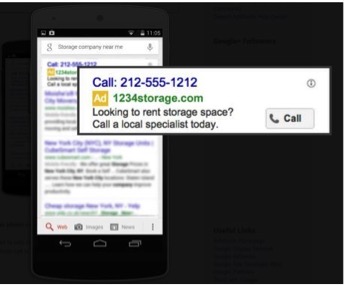
What Businesses Need This Feature?
If the vertical depends on phone calls above all else, it’s likely to succeed greatly with call-only campaigns. Before writing this piece, I only had numerous, extensive discussions with a multitude of clients in different industries to rely upon. In plenty of discussions, numerous clients had assured me so adamantly that their business was so phone call oriented that they were sure to see success with the option.
But Matt Umbro asked me if I had data to back my assumptions. In the world of PPC, data is vital, but I had no metrics to fall back on. What made this feature a good option for some and poor for others?
It occurred to me that the ratio of users that chose the click-to-call feature on mobile vs the total number of mobile clicks would be a sure sign. We can call it the Mobile Click-to-Call Rate.
To find this data, first use the Segment option for ‘Click type.’
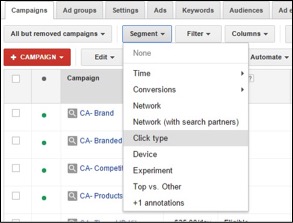
Then at the bottom, expand the ‘Total – Search’ option and record the ‘Mobile clicks-to-call.’
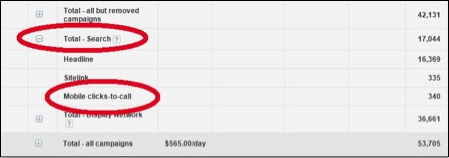
To access the total mobile clicks, choose the segment option for ‘Device.’
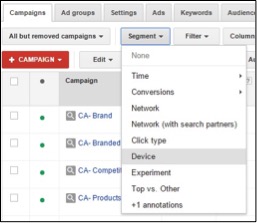
Then expand the selection for ‘Total – Search’ and record the statistic for ‘Mobile devices with full browsers.’
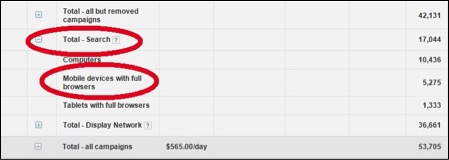
Now divide the first number by the second number, and you have your Mobile Click-to-Call Rate metric.
This does not mean the number of mobile clicks that turned into calls from the Click-to-Call feature, because users can choose not to place the call after the click. The user is actually presented with the following option after clicking as shown in the screenshot below.
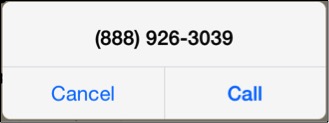
Allow me to present to you one bail bond client I was working with at the time. It’s important to note that there are some ways that users can still get to the website using the option that would be counted as a click but not a call.
Before The Change
May ‘13: 57% Mobile Calls Vs Clicks
June ‘13: 57% Mobile Calls Vs Clicks
After The Change In The Middle of July 2013
August ‘13: 94% Mobile Calls Vs Clicks
September ‘13: 95% Mobile Calls Vs Clicks
February ‘15: 95% Mobile Calls Vs Clicks
Notice that that mobile click-to-call ratio hovered around 57% before the change. While the 95% in the months following seems natural since I basically forced users to call, it was clear a large percent were ready to do so already.
While the client in this scenario was averse to using the Google Voice Numbers and call tracking, the client was happy about call volumes after activating the option. When I tested turning the option off again the client was frustrated with the drop in calls.
So what about other industries? Were bail bonds abnormal? Check out the following accounts for the entire year of 2014:
HVAC: 22% Mobile Click-to-Call Rate
Foundation Repair: 18% Mobile Click-to-Call Rate
Law Firm: 15% Mobile Click-to-Call Rate
Towing: 45% Mobile Click-to-Call Rate
Limo Service: 14% Mobile Click-to-Call Rate
Chiropractor: 3% Mobile Click-to-Call Rate
I do not have significant data using the call-only option for any of the above clients. What I can speak to is the notion that most of the users on the HVAC, Foundation Repair, Law Firm, and Chiropractor accounts were not ready to place a phone call immediately. Based on the extensive conversations I had with the owner of the limo service, I was certain their account would be ripe for the call-only option. But according to the Mobile Click-to-Call Rate metric, too few users are ready to pick up the phone without researching the website first. Forcing them further down the sales funnel would be counterproductive. On the other hand, if I were still managing the Towing account, I would certainly test the call-only option for them.
While many businesses would love to pay only for phone calls, users often have different goals. I’ve heard of the occasional person that needed a bail bond but would complain to the client about not being able to get to the website easily. The call-only option helped generate leads much more effectively than without using the feature. The occasional losses were easily outweighed by the major increases.
But even if their users may want to call them first, what are some of the other considerations for a business to use, or not use Call-only campaigns?
Many small start-up businesses, service industries like plumbers, electricians, HVAC technicians, and pest control companies, as well as non-service industries like attorneys – fall into the category of “test it first.” The smallest of these businesses may not care about pricing as much as many depend on almost any leads to make money. However, more established businesses may be negatively affected by having a higher percentage of questionable quality calls.
Imagine the small landscaper that works out of his home. Perhaps he has a few workers he can rely on, but he can do the majority of the work. His own paycheck is his largest concern. His goal is to close any lead that comes through, as he knows he likely won’t get the high dollar work. Any jobs that take anywhere from a day to a month are all fine for his business.
Now image the landscaping company with multiple trained crews. These crews depend on consistent work, and the two-day job rarely cuts it. Administrative costs require higher fees. Too many low-quality leads make it harder to discern which are relevant, and to make time to nurture the good ones. This can play havoc with the sales process and thus the business is hurt. One bad season can be very costly.
It’s not just the service industry that has to consider the possibilities. A couple attorneys trying to cut their teeth in the legal field might do just fine servicing users that aren’t as concerned about doing research. But an established law firm might find the extra calls superfluous and disruptive.
The Call-Only Campaign Type Purpose
If the option was already available to make the call extension phone call only, why did Google bother upgrading it to a separate campaign type?
Google made this move for three reasons:
- Many people were displeased about limitations imposed by Enhanced Campaigns, as Enhanced Campaigns did not allow mobile campaigns from being segmented from desktop campaigns.
- Many felt call-only campaigns would perform much better for specific industries than regular campaigns.
- Google believes the tipping point of mobile traffic has arrived.
While Enhanced Campaigns may offer the option to increase the bid modifier for mobile devices, they also force mobile and desktop ads to be optimized together. This structure can create worse results for accounts.
Part of the issue is how valuable phone calls are versus the ability for the user to research the website of the company. In the aforementioned companies that should use this new campaign type, Call-only campaigns have generated an incredible lift in business. It just made too much sense for Google not to promote a specialized campaign type.
Google has been hesitant to do anything that reduces competition and the average cost-per-click on desktops and tablets. On the other hand, Google may believe it can generate a great deal more mobile competition in certain verticals by pushing mobile only campaigns that only allow phone calls.
Conclusion
For some industries, these campaigns are an absolute must. But in other industries, users that are not ready to call yet are simply not going to click a call-only ad. The assumption about these campaigns is that they will generate more calls, but they may also deter some users from clicking. The user with more money may rely on referrals from people they know, and the inability to click to a website may create difficulty in researching those referrals. The only way to be confident before testing this is to look at the Mobile Call vs Clicks ratio.



